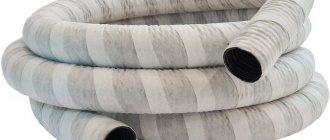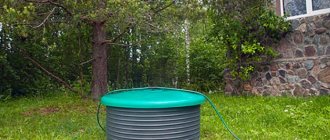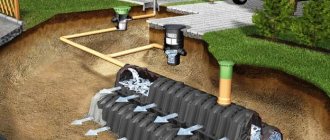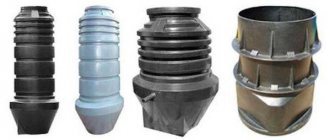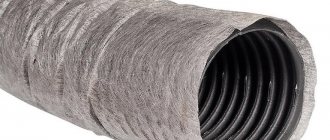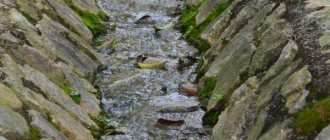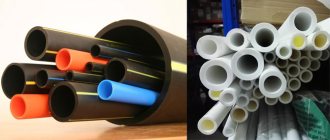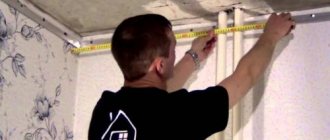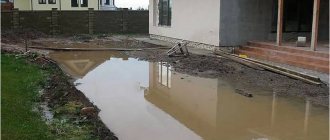As an advertisement
If for professional builders the importance of geotextiles is like an axiom: obvious, proven and undeniable, then private developers are not well enough aware of all the possibilities of this unique material. This picture does not always develop, but quite often. The use of geotextiles in private construction is not so uncommon (rather, on the contrary). But, unfortunately, this material is used quite rarely correctly and for its intended purpose.
It is very easy to make a mistake in choosing geotextiles. Therefore, very often, not only those who completely abandoned this material, but even those who were able to find use for it on their own personal plot have to regret missed opportunities. Paradox? Yes. But the explanation for such an intricate curiosity is very simple: geotextiles are not a finishing solution, which, if it does not correspond to the chosen style, can always be changed (if desired). This is the material that forms the basis, and if the geotextile was chosen incorrectly, then even the most expensive and high-quality material will bring nothing to the owner except costs and disappointments.
Avoiding superficial judgments, we will try to delve into the very essence of the problem. Let's find out, for example, why for the construction of an access road it is necessary to use Dornit geotextiles with a density of 350 g/m2, and not some other? Why is it undesirable to use this same material in the construction of drainage sewers? There are many questions, and so that the most important information is presented logically and consistently, let’s get acquainted with the types and features of the use of geotextiles.
General concept of geotextiles
By definition, geotextile is a special type of synthetic fabric that is manufactured using various technologies and has different physical characteristics. Manufacturing technology and material density are the key factors that determine the final purpose of the geosynthetic fabric. Geotextiles are used:
- in road construction:
- in private and industrial construction;
- in agriculture and even in medicine.
Nowadays, geotextiles are increasingly used in landscape design and private construction:
- Being part of drainage systems, geotextiles protect the perforation of underground pipes from clogging, and bulk materials from mixing with the soil and from spreading (thereby it extends the service life and increases the efficiency of drainage communications).
- The use of geotextiles during the construction of the foundation is an opportunity to provide additional reinforcement of the base. Strengthening the underlying layer (for example, sand bedding), protecting it from mixing with natural soil - all this helps to reduce the consumption of building materials and reduce construction shrinkage.
- During the construction of a roadway, geotextiles protect crushed stone from mixing with the soil, thereby allowing the thickness of the asphalt pavement to be reduced without losing its quality (the same functions are performed by geotextiles during the construction of pedestrian paths).
- It is completely impossible to imagine the improvement and decoration of a personal garden without geotextiles. It provides mechanical protection for film waterproofing used in the construction of reservoirs. Geotextiles also help protect decorative hills or landscape terraces from crumbling. Geosynthetic fabric increases the load-bearing capacity of the soil by an order of magnitude, and this quality is in demand wherever there is a need to strengthen bulk layers or protect materials susceptible to mechanical damage.
Parameters for selecting geotextiles for drainage
Russian and foreign manufacturers produce a wide range of geotextile options, but not all of them are suitable for drainage work. When selecting, you need to pay attention to the following parameters:
- Density, that is, the mass of one square meter. m of geotextile covering. The higher the density, the greater the tensile strength, but the less ability to transmit moisture. The optimal density of geotextiles is 100-150 g/m2, and denser varieties are used for reinforcing road surfaces.
- Filtration coefficient is a key parameter when choosing a drainage layer. This indicator determines the amount of water that the material is able to remove within 24 hours. The filtration coefficient is related to density: if the material has a density of 100 g/m2, it is capable of passing through a column of water 140 meters high in one day. If we take material with a density of 500 g/m2, then this figure will be only 80 meters.
- Strength and width of the material. High-quality geotextiles can withstand strong mechanical loads for a long time; they are resistant to pushing and stretching. The width of the rolls varies from 2 to 5 meters; if necessary, geotextiles can be easily cut right on the job site.
The most common solution for drainage systems has become geotextile Dornit - this is a needle-punched geotextile material on a polypropylene base. The optimal density should not exceed 150 g/m2, the filtration coefficient for soils with high water inflow should be 140-125 m/day. The optimal level of bursting strength is at least 400-500 N, the permissible breaking load should be 1.9-3 and 1.5-2.4 kN/m, respectively, in the longitudinal and transverse directions.
Such parameters ensure maximum efficiency of the drainage system: the material is able to drain a large amount of water, while it has high tensile and tensile strength. The drainage system will last a long time, and it will do its job perfectly. When choosing geotextiles, it is better not to save money, since cheap material can quickly lose its properties, and the drainage system will have to be restored.
Possibility of using drainage geotextiles
Geofabric for drainage can be used on sandy and rocky soils, as well as on clay soils, where a layer of crushed stone is used to drain groundwater. Geotextiles in drainage systems perform several functions simultaneously:
- Prevents soil subsidence. It plays the role of a reinforcing layer to evenly distribute the load on the surface, so holes and potholes will not appear on it.
- Prevents silting of drainage pipes. The material allows water to pass through, but does not allow the pipes to become clogged with particles of soil, silt and sand, so the system remains operational longer.
- Increases the strength and reliability of drainage structures. The use of geotextiles reduces repair and maintenance costs, drainage pipes are reliably protected from the penetration of foreign particles.
Geosynthetic fabric is used to isolate the crushed stone layer from the ground, resulting in the removal of groundwater through pipes and drainage of the area. Since this material is sensitive to sunlight, it is removed from the packaging only immediately before installation, and after laying the pipes in the trench, the geotextile material is completely covered with soil. The panel must be wide enough to completely cover the drainage system, and the edges must overlap.
The geotextile fabric is laid on the bottom of the prepared trench, the edges of the material are located along the slopes. A layer of crushed granite stone is placed on top of the canvas - this material is resistant to erosion and ensures effective drainage. After this, a drainage pipe is laid, it is covered with crushed stone on top, after which the geotextile fabric is wrapped and covered with soil.
Such a system has proven its effectiveness in draining wetlands; with the correct selection of material, it can drain large amounts of water and remain operational for a long time.
Features of laying geotextiles
When arranging a drainage system, it is necessary to strictly follow the rules for using geotextiles. Damaged areas should not be placed in the trench; such fragments must be replaced. When laying the material, it should not be stretched too much: tension will not provide significant savings on geotextiles, but at the same time it will create a significant threat to its strength.
It is possible to compact a layer of crushed stone during laying only if its thickness is at least 20 cm. Otherwise, there is a risk of damage to the thin geotextile layer, and it will not be able to cope with its responsibilities. After filling with crushed stone, the edges of the geotextile are wrapped, and they should overlap each other by at least 20 cm.
When properly installed, the geotextile layer can last more than 25 years, while it fully retains its water-permeability qualities. Such products are resistant to constant exposure to moisture, the canvas does not rot or collapse. It retains strength under sudden temperature changes and can withstand temperatures up to +135 degrees. The correct selection of geotextiles guarantees its durability and efficiency: the system will do an excellent job of draining water from the site, as well as from the foundations of buildings.
offers to purchase geotextiles for drainage made in Russia and abroad; domestic products are not inferior in quality to imported ones, but are cheaper. Our consultants will help you choose a material of suitable density and structure so that the drainage system is as durable and effective as possible. It is proposed to place an order with delivery: you can make a profitable purchase, and it will be delivered to any location.
Raw materials for the production of geosynthetic fabric
Most often on sale you can find geotextiles made from polyester and polypropylene fibers. Thanks to its high strength and durability, polymer geotextiles have gained popularity in the construction industry and agriculture - where these qualities are valued most.
Less common are geotextiles made of fiberglass and various natural inclusions (textile industry waste: cotton, wool, etc.). The use of natural fillers somewhat limits the scope of application of the material. Such fabric, for example, is not recommended for use in the construction of drainage communications, since it quickly wears out, and this leads to clogging of drainage systems.
Polypropylene geotextile
Geo-fabric made of continuous polypropylene fibers is a material based on a thermoplastic polymer with increased chemical resistance. Polypropylene fibers are a product of the polymer industry, which is a primary, that is, unprocessed raw material. The use of solid fiber gives the fabric high strength, but when exposed to sunlight, polypropylene threads quickly lose their strength. This problem is fixable: by adding chemical stabilizers to the product that protect it from exposure to ultraviolet radiation, polypropylene geotextiles are successfully used in a wide variety of areas of human activity. The relatively high cost of polypropylene geotextile is a consequence of the technological features of production.
Consideration of the general advantages of the material
An important advantage is the high level of resistance to aggressive environments, so the service life of the products when in the ground is very long. Due to sufficient elasticity, the material sheets do not tear on stones and other objects encountered during installation.
When filling with gravel, the geotextile is not damaged
The strength of geotextiles is very high. Plant roots, stones, soil movements and other light mechanical impacts are not capable of damaging the integrity of such canvases. Despite the increased strength characteristics, the material can be cut well with a regular knife.
The material is quite convenient to work with
The polymer layer retains its basic characteristics in the temperature range from -60 to +110 degrees, that is, abnormal heat or severe frosts do not have a negative impact on it.
Polyester Geotextile
Polyester geotextile is a material made from short polyester fibers. They are based on recycled materials (plastic waste, polymer production waste, etc.), which significantly reduces the cost of the canvas, but gives it sufficient strength.
A suitable example of quality, durability and practicality is Dornit brand polyester geotextiles with a density of 250 g/m² - a popular and economical solution for low-rise construction, landscape design and complex landscaping of homestead areas.
With this, the classification of geotextiles based on materials of manufacture can be completed. There are not so many options, and their differences are clear even to the uninitiated.
The situation with production technology is much more interesting, because the area of application of geotextiles depends on it.
Based on the manufacturing method, geotextiles are divided into two main types: woven and non-woven.
Woven geotextile
Woven geotextiles (geofabric) are made using classical technology, which is based on the mutual interweaving of longitudinal and transverse fibers. This material has high tensile strength and can withstand breaking loads well. These qualities determine the area of application of geofabric:
- construction of reinforced earth embankments;
- arrangement of retaining fortifications;
- arrangement of foundations with complex configurations;
- road construction;
- complex construction work, construction of engineering infrastructure and so on.
Variety of structures
The performance properties of geotextiles directly depend on its structure. Depending on the task at hand, a specific option is chosen. Functions such as water drainage, moisture resistance and much more are provided by the structure itself.
Lattice
Non-woven fabric. The polymer strips are reliably connected to each other in a checkerboard pattern, resulting in the formation of cells.
Net
This is a flat fabric in terms of volume. Strips of material can be connected in various ways:
- at an angle;
- closely intertwined with each other;
- perpendicular
The cells are larger and more voluminous.
Geomat
The material is characterized by a chaotic connection of fibers or threads. Elements are fastened using three methods:
- thermal;
- mechanical;
- chemical
Geomat has excellent flexibility and lightness. It allows water and air flow to pass through unhindered.
Geocell
Large non-woven fabric with three-dimensional cells. The second name of the product is volumetric geogrid. The canvas is made in the form of a honeycomb from polyethylene tapes. The material is fastened using a welding method, ensuring a reliable and durable connection. Due to the transformation of its shape, it is convenient to store and transport.
Membrane
The section includes three varieties.
- Geomembrane is a dense material. Geotextile is impermeable to liquids.
- Bitumen-geosynthetic – geofabric with a bitumen layer.
- Clay-geosynthetic fabric. Material with a clay layer.
The main area of use of memrans is equipment for the bottom of artificial reservoirs: ponds, streams, lakes.
Clay mat
The material consists of three layers. The two outer layers are geotextiles connected using a needle-punched technique. Clay is placed between them. After which they are securely connected by stitching.
Geoband
Narrow canvases, the width of which does not exceed 90 centimeters. The fabric features technically designed edges. The material is often produced by cutting strips of wide geosynthetic material.
Bentomat
Rolled material made using the needle-punched method. Manufacturers combine woven polypropylene geomaterial with non-woven fabric. A special insulating layer is placed in the middle. It consists of special granular sodium bentonite.
Geocomposite
Multilayer geofabric. The minimum number of layers is two. There are two types: reinforcing and draining material. But companies also use the terms: reinforced geocomposite and geodrain.
Main technical characteristics:
- a high-quality product, manufactured in accordance with all standards, has excellent strength;
- tensile strength reaches several hundred kN/m, while the elongation is no more than 18%;
- increased density of geofabric, this indicator varies from 80 to 1200 g/m2;
- factors such as water and air permeability, service life, soil compaction and much more are individual and must be clarified when purchasing the material.
Non-woven geotextile
Non-woven geotextiles, in turn, can be thermally bonded and needle-punched. In the first case, geotextile fibers are bonded together under the influence of high temperature, in the second - under the influence of a mechanical press with needles.
Thermally bonded geotextiles are made exclusively from polypropylene fibers. This determines its main qualities: strength and elasticity.
Thermally bonded geotextiles are successfully used to strengthen the soil during construction on slopes. Also, its qualities can hardly be overestimated if you are planting trees or improving plant areas (it retains moisture well, thereby allowing you to increase the intervals between watering plants by an order of magnitude). But due to the low filtration coefficient, this material should not be used in the construction of drainage communications, because it allows water to pass only in the transverse direction.
Which geofabric to use for drainage: features of choice
Consumers are offered a range of geotextiles for drainage; the price per m2 depends on the characteristics of a particular material. It is not recommended to use canvases made from mixed fabrics, as over time they are washed out, and at the same time the ability to filter liquids is reduced.
The geotextile for the drainage system is selected with a reserve, so that the raw materials are placed with the outlet
It is worth considering the filtration rate indicated by the company. The optimal filtration coefficient varies from 125-140 m/day. If groundwater is located high, then the value should be even higher.
The cost of the product depends on the manufacturer and density value. Material from specific manufacturers and its price can be viewed in the table.
| Image | Manufacturer | Density, g/m³. | Cost, rub. per sq. m. |
| Geotex | 150 | 19 | |
| Avantex | 100 | 15 | |
| Dornit | 200 | 22 | |
| DuPont | 90 | 1500 per roll | |
| Kanwalan | 150 | 22 | |
| Geocom | 100 | 15 | |
| Technohaut | 60 | 770 per roll |
Variety for foundation protection
The durability of the building depends on the quality of the foundation. To protect the building from being washed away by groundwater, you need to properly arrange the drainage system. Before work, you need to determine the depth of groundwater. This will help you choose crushed stone, pipes and geotextiles.
The use of high-quality materials for blind areas prevents moisture from melting inside the house
A trench is dug along the contour of the foundation. It is done with an inclination. The width of the notch is calculated taking into account the diameter of the pipes.
If there is a blind area, then the recess is located along it. Sand is poured to the bottom, and then geotextiles are laid, which are sprinkled with crushed stone. Pipes and crushed stone are placed on top. The layers are covered with geofabric, which is fixed with wire.
Dornit: non-woven geotextile for various uses
Dornite is considered one of the popular materials. It is a sheet of polymer substance. Before purchasing a product, you need to familiarize yourself with the technical characteristics of dornite geotextiles. This heat-treated and needle-punched geofabric is designed to withstand stress.
The production technology allows the products to be used in the construction of highways, for laying pipelines, as a base for paving slabs and for parking lots. Dornite is intended for separating layers of a drainage structure, to increase the strength properties and to protect against the processes of leaching of soil rocks.
Dornit geofabric is distinguished by its density and quality indicators
Drainage structure for a garden plot
The passage of groundwater harms the plants that grow in the garden.
Geotextile is used for certain types of seedlings. It protects the plant from weeds
To drain water from the territory, trenches are dug along the perimeter into which narrow pipes are placed. They are divided into separate elements and fixed on the spreads using tees. In this case, each section of the highway is wrapped with geofabric. Then crushed stone, geotextiles, crushed stone and a layer of soil are laid out.
With the help of this material beautiful paths in the garden are arranged.
Price for geotextiles per sq.m.
The average cost of geotextiles is about 10-20 rubles per square meter. Products from domestic manufacturers have a low price. Before purchasing, you need to study the properties of the product. It is worth finding out the cost of installation in advance. The price for such a service starts from 35 rubles per square meter.
Needle-punched geotextiles are an indispensable solution for private construction
To produce needle-punched geofabric, both short and continuous polymer fibers are used. The mechanical method of fastening fibers simultaneously gives the fabric both strength and a high filtration coefficient. This significantly expands the scope of its application. Considering that modern technologies make it possible to produce material with specified density parameters, it is difficult to find a more suitable synthetic fabric for private construction than needle-punched polyester geotextiles.
Rules for using geotextile when arranging drainage
Laying the geo-fabric is very simple, since the canvas is easily cut with a knife and rolled up to take the desired shape. To achieve effective drainage, you need to follow simple rules:
- Being exposed to the heat for a long time under the sun, the geo-fabric can deteriorate its filtering qualities. It is optimal to unpack the material immediately before use and immediately cover it with soil.
- To prevent the canvas from tearing, it must be laid in the trench after leveling the bottom and side walls. The fabric should not be too stretched and without folds. If a hole has formed on the geo-fabric, this piece must be cut off and then replaced with a new one.
- The width of the canvas is selected so that it can overlap the pipe with drainage filling. Here you need to make calculations before installing the drainage system. The cross-section of the pipe, as well as the thickness of the fill, are taken into account. Ideally, drainage is obtained if it is enough to roll out a single piece of geotextile along the trench.
- To have a better idea of laying the geofabric, let's take a closer look at the drainage arrangement scheme. So, a cloth is spread at the bottom of the trench. Its edges should extend beyond the pit, where they are temporarily pressed with a load. Crushed stone about 300 mm thick is poured on top of the geotextile. Next, the pipe is laid and backfilled with a similar layer of crushed stone. After this, the free edges of the geotextile are overlapped around the entire filter system. Finally, the trench is backfilled with soil.
If the laying of the crushed stone geotextile and pipes was done correctly, the drainage system will function properly for many years.
The video talks about geotextiles:
Selecting suitable geotextiles for drainage installation is not difficult. As a last resort, you can use the recommendations of sellers. The main thing is to strictly follow the technology of laying the material.
Density of geotextiles and areas of its application
For private construction, for work related to landscaping, as well as for the construction of temporary local roads, construction experts recommend using Dornit needle-punched polyester geotextiles, the density of which varies from 150 to 350 g/m².
On the one hand, this material is inexpensive, thanks to which the average private developer can purchase it without any problems, on the other hand, the characteristics of the material fully correspond to the listed areas of application. The Dornit classification by density has a step of 50 g/m², and each subsequent classifier step has its own narrowly targeted purpose.
To understand how to choose the right fabric based on density, let’s look at several examples of the intended use of needle-punched geotextiles.
Important points when purchasing material
Carefully read the following recommendations before purchasing geotextiles and starting work:
- study the properties of the soil. This is a key factor on which both the density of the canvas and the filling of the drainage trench will depend;
- select the type of geofabric in accordance with the material of the drainage itself. Consultation with a specialist is not excluded;
- the manufacturer plays an important role: if you have heard about a supplier with a solid reputation, you should trust public opinion. This way, neither financial nor time resources will suffer;
- Do not place unjustified hopes on geotextiles on particularly “wet” soils with abundant melt water. In such cases, it is advisable to resort to installing drainage pipes.
Geotextile with a density of 150 g/m²
Geotextile "Dornit" 150 g/m² was developed specifically for the construction of drainage systems and for strengthening the soil when organizing drainage communications. The small pores of denser geotextiles quickly become clogged with solid microparticles of soil, thereby reducing the filtering capacity of the material. At the same time, the material, with a density of 150 g/m², is ideal for drainage and excellently strengthens weak foundations.
Popular brands
The most popular products from foreign manufacturers are: NETEX A - Czech Republic, Typar - USA, Terram - England, Polifelt - Austria. Geotextiles for drainage Dornit and Drenotex are popular in Russia.
Often the quality of the fabric for arranging drainage systems does not correspond to its cost, so it does not always make sense to purchase expensive foreign material. It is better to choose geotextiles that meet certain requirements and have the required density and strength.
Geotextile with a density of 200 g/m²
Geotextile "Dornit" 200 g/m² is designed to strengthen unstable and weak soils. It is used in the following situations:
- when it is necessary to arrange a lawn on a personal plot: to stabilize the soil or protect the soil from deformation;
- when it is necessary to strengthen an unused embankment;
- during the construction of pedestrian paths and decorative slopes.
Most often, people who engage in landscape design use material with a density of 200 g/m². With its help, you can effectively separate layers of soil in unexploited areas or protect lawns from the germination of weeds.
Drainage system for garden plot
Too close a location of groundwater can have an extremely negative impact on the life of plants growing in the garden. However, a way to combat this phenomenon was invented long ago, and today it is quite easy to implement even with your own efforts.
In order to drain water from the site, it is necessary to dig narrow trenches in the form of a “herringbone” throughout its entire area. They will contain narrow pipes with a diameter of 6.3 cm. They are cut into pieces of the required length and connected at the turning points using special tees.
It is at this phase that it is necessary to pay attention to the role of geofabric. It is necessary to make a drainage pipe in the geotextile filter. Each section of pipe must be wrapped with geofabric at least three times, and the winding must be secured with wire.
After this, the layers are laid out in the following order: crushed stone, geotextiles, crushed stone, earth.
Drainage system laying diagram.
On a note! At this stage, the geotextiles must be overlapped to provide more reliable protection.
Geotextile with a density of 250 g/m²
Needle-punched geotextiles with a density of 250 g/m² are chosen by those who plan to undertake large-scale construction work on their own personal plot. This material is optimal for strengthening the soil under the foundation by laying a sheet under a sand cushion. It reliably separates the shock-absorbing bedding from the main soil and allows you to evenly distribute the loads along the entire perimeter of the foundation. At the same time, Dornit 250 g/m² is successfully used to strengthen blind areas, as well as for mechanical protection of polymer film used in the construction of swimming pools and artificial reservoirs.
Uniqueness
There is no replacement for geotextiles used in the construction of a drainage system.
This material is so unique that it has no analogues. It is thanks to its use that beautiful paths covered with natural tiles can be laid on the territory of a personal plot with drainage. At the same time, they will last for many years, maintaining their original appearance. Of course, reliability and quality require significant financial expenses. But it is better to pay once and purchase geotextiles than to constantly repair the drainage structure in the garden.
Geotextile with a density of 350 g/m²
Needle-punched geosynthetic fabric, with a density of 350 g/m², has also become widespread in private construction. This material is most suitable for the construction of reliable access roads, car parks or massive foundations. It can also be used to solve other problems that have a similar purpose and corresponding level of complexity.
Correct styling
Even experts cannot give a definite answer to the question of which side to lay geotextiles on. Some of the craftsmen are of the opinion that this material can be placed on any side and it does not matter whether it is smooth or rough, since its properties do not depend on this.
If you read the included instructions, some manufacturers recommend laying geotextiles with the smooth surface down. If such instructions are available, then they will certainly indicate which side to cover the drainage structure.
Other experts believe that a rough surface will provide stronger adhesion to the soil. But the best solution would be to follow the recommendations on how best to lay geotextiles in the drainage system, prescribed in the instructions.
The main advantages of Dornit brand needle-punched geotextiles
The key advantages of the presented material lie in the almost unlimited scope of its application, as well as in the unchanged performance characteristics throughout the entire period of operation (which, by the way, reaches 25 years). It is characterized by:
- strength and durability, which are achieved by using non-degradable geosynthetic materials;
- resistance to vibrations and temperature changes;
- good filtering ability even under extreme operating conditions (intense vibrations, strong mechanical pressure, etc.);
- environmental friendliness and affordable cost.
By the way, about the cost: the price of the material includes all the costs that are required by impeccable adherence to production technology, the cost of purchasing high-quality raw materials, as well as the cost of operating high-tech production equipment. If you like geotextiles that are too low in price, it means that one or another cost item is not included in its cost. Consequently, the material was produced in violation of technology or using low-quality raw materials.
It is impossible to create high-quality material without appropriate investments, so cheap geotextiles will have neither reliability nor durability. By purchasing geosynthetic fabric from official dealers who directly cooperate with the manufacturer, you will always receive guaranteed quality at a reasonable and reasonable cost.
Subscribe to our Telegram channel Exclusive posts every week
In what price category should I buy geotextiles?
This depends on many factors:
- type of drainage system (surface or deep);
- soil properties on the site;
- organization of drainage (through collectors or by gravity into the river);
- drainage materials.
As operating conditions become more complex, the requirements for the physical and technical characteristics of the canvas increase. Of course, high-strength geotextiles cannot be cheap.
For wetlands, it is better to choose a geosynthetic material with a density of no higher than 150-200 g/m³.

